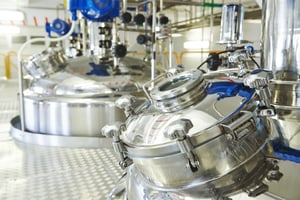Selecting the optimal method to measure liquid tank level is an extremely important decision when starting your project. Making the right choice helps ensure that both vented aboveground and in-ground tanks as well as pressurized tanks work properly. This means that homeowners will receive water for drinking, water will be available to fight fires in remote residential areas, manufacturers will maintain their industrial processes, and food and beverage companies will continue to produce with less down time. To accomplish this, system designers must take into account the tank type and application to properly measure the liquid in their tanks.
Hydrostatic Method (Vented Tank)
Walking the fine line between cost and accuracy is something every system designer faces when they begin a project. One of the most preferred methods to use to achieve that cost vs. accuracy battle is the hydrostatic method. The hydrostatic method utilizes simple physics to yield great results for tank level applications. Using a liquids specific gravity and column height you can determine pressure caused by that liquid. Utilizing a gauge (vented to atmosphere) pressure transducer, a user can get real-time tank level even in the most rapidly changing tanks. A pressure transducer will read any height above the diaphragm of the sensor, so the mounting location is extremely important.
Hydrostatic Method (Sealed Tank)
Just as in the vented tank application the basics of tank level will still be in play. The key difference is that in a sealed tank there is often a blanket pressure (of an inert gas) that resides on the liquid you are trying to measure. Sealed tanks are used when you are dealing with a fluid that either has a rapid evaporation time or the fluid gives off a dangerous byproduct. An example would be a plant that manufactures isopropyl alcohol; if the product was stored in a vented tank the product would eventually evaporate completely.
In these kinds of applications, if you were to use a gauge style pressure transducer mounted at the bottom of the tank, not only will you be measuring the liquid level, but you will also be measuring the effect the blanket pressure is causing on that liquid. This will give you a substantial difference in your liquid level measurements. In order to make sure you are only measuring the liquid inside of the tank you want to subtract the blanket pressure from the equation. This can be accomplished in multiple ways, but the simplest way is to utilize a true differential pressure transducer. A differential pressure transducer has two pressure ports; a high port and a reference port. Where these two pressure ports are located will help you determine your liquid level; the high port will be plumed into the bottom of the tank and reference port will be plumbed into the top of the tank (where the blanket pressure is located).
Above Ground Application
When you are selecting the range of your transducer it is important to know the column height above the sensor to ensure that you have a large enough pressure range to cover your application. Using the calculation below you can see the required range of sensor based on the mounting location and better decide on which works best for you. In this example there is a difference of 75 feet depending on the sensor’s location. This difference in elevation will need to be factored in when selecting your pressure range.
In-Ground Application
For in-ground application, all of the same methods and principles still apply, but the unique aspect is that you no longer have the ability to connect a sensor externally to tank in most cases. In this type of application you will be accessing the tank through an access hatch or drilled hole in the top of the tank. All methods, other than the common sight glass, of tank level measurement can still be viable options even in a in-ground installation. The main change is that when you are utilizing the hydrostatic method, you will need to use a submersible pressure transducer or mount the sensor in a submersible enclosure. Some typical application for in-ground applications are oil tanks, sewerage wet wells, water storage tanks, and even in the non-traditional sense lake and pond water depth.
CLICK HERE to view Setra's Pressure Range Calculator for Vented and Sealed Tank Level Applications.


